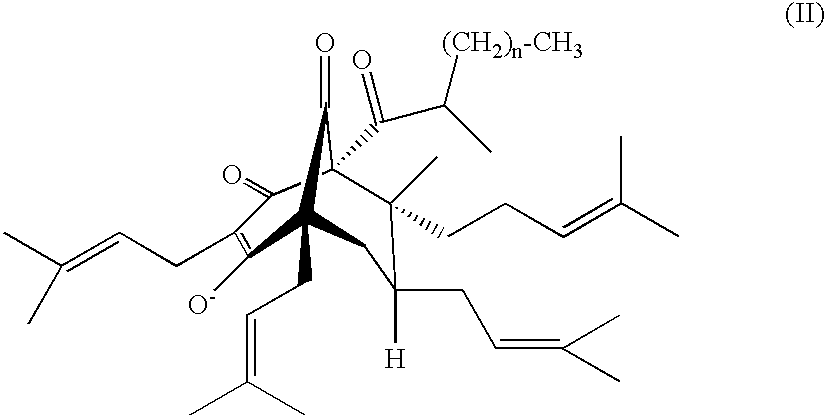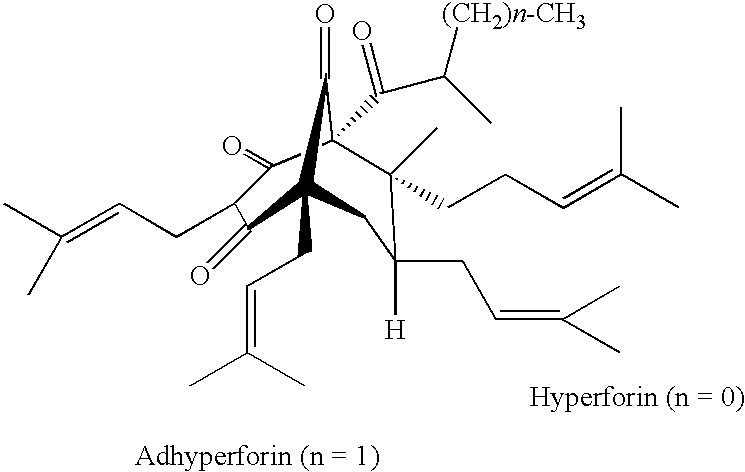Stable hyperforin salts, method for producing same and their use in the treatment of alzheimer's disease
a hyperforin salt and stable technology, applied in the field of stable hyperforin salts, can solve the problems of increasing memory disturbance, loss of other cognitive abilities, and inability to stabilize hyperforin, and achieve the effect of increasing the concentration of acetylcholin
- Summary
- Abstract
- Description
- Claims
- Application Information
AI Technical Summary
Benefits of technology
Problems solved by technology
Method used
Image
Examples
example no
Method A
Hyperforin Sodium Salt.
728.5 mg (1.31 mmol) 96.5% hyperforin is dissolved in 80 ml methanol, reacted with 5.1 ml (1.32 mmol) 0.259-molar methanolic sodium hydroxide solution, allowed to stand for a short time, and the solution evaporated at 50.degree. C. The residue is dissolved in water and lyophilised. Yield: 746.7 mg of a white powder (101% of theoretical). Mp.: Sintering between 90.degree. C. and 110.degree. C., degradation at 170.degree. C. IR: 1449 cm.sup.-1 (sv, broad). .sup.1 H-NMR: no impurities apart from approx. 1.4 mol % (0.08 weight-%) methanol visible. C.sub.35 H.sub.51 NaO.sub.4 (558.78). Calculated / recovered: C (75.23 / 71.61), H (9.20 / 8.87); Na (4.11 / 4.6). Hyperforin content (HPLC): 86.5%.
example no.2a
EXAMPLE NO. 2a
Method B
N,N-Dicyclohexylamine Salt of Hyperforin.
1 g (1.86 mmol) hyperforin is dissolved in 50 ml n-pentane / methanol 98 / 2 vol / vol, reacted with 445 .mu.l (2.33 mmol) dicyclohexylamine and allowed to stand for 10 h at 4.degree. C. Precipitated product is drawn off by suction over a sintered glass filter, washed with pentane and dried under vacuum at room temperature. Yield: 652 mg of a white powder (48.7% of theoretical). Mp.: 157.2.degree. C. IR: 1473, 1489 cm.sup.-1 (sv). C.sub.47 H.sub.75 NaO.sub.4 (718.13). Calculated / recovered: C (78.61 / 76.91), H (10.53 / 10.42); Na (1.95 / 1.70). NMR: In addition to the signals of hyperforin, the following signals of dicyclohexylamine are visible: .sup.1 H-NMR: 3.15 (m; 2 H; 1-CH) and (partially overlapping) 1.82-2.08 (m, 2- and 6-CH.sub.2), 1.42 (quint, 3-, 4-, and 5-CH.sub.2). Dicyclohexylamine / hyperforin quotient=1 / 1. No visible impurities. .sup.13 C-NMR: 54.65 (1-CH), 30.72 (2- and 6-CH.sub.2, 26.06 (4-CH.sub.2) and 25.64 (3- and ...
example no.2b
EXAMPLE NO. 2b
Method B
N,N-dicyclohexylamine Salt of hyperforin.
1.547 g (2.82 mmol) 98% hyperforin is dissolved in 60 ml n-heptane / isopropanol 98 / 2 vol / vol, reacted with 600 .mu.l (3.0 mmol) dicyclohexylarnine and allowed to stand for 18 h under N.sub.2 at room temperature. Precipitated product is drawn off by suction over a sintered glass filter, washed with heptane and dried under vacuum at room temperature for 8 h. Yield: 1.767 g (2.46 mmol) of a white powder (87% of theoretical). Mp.: 159.7.degree. C. IR: 1473, 1489 cm.sup.-1 (sv). .sup.1 H-NMR: corresponds to the .sup.1 H-NMR spectrum of example 2a. C.sub.47 H.sub.75 NO4 (718.13). Calculated / recovered: C (78.61 / 78.59), H (10.53 / 10.66); N (1.95 / 1.87). Hyperforin content (titration with HClO.sub.4): 100%.
PUM
| Property | Measurement | Unit |
|---|---|---|
| Fraction | aaaaa | aaaaa |
| Fraction | aaaaa | aaaaa |
| Fraction | aaaaa | aaaaa |
Abstract
Description
Claims
Application Information
 Login to View More
Login to View More - R&D
- Intellectual Property
- Life Sciences
- Materials
- Tech Scout
- Unparalleled Data Quality
- Higher Quality Content
- 60% Fewer Hallucinations
Browse by: Latest US Patents, China's latest patents, Technical Efficacy Thesaurus, Application Domain, Technology Topic, Popular Technical Reports.
© 2025 PatSnap. All rights reserved.Legal|Privacy policy|Modern Slavery Act Transparency Statement|Sitemap|About US| Contact US: help@patsnap.com



